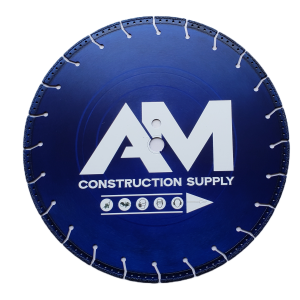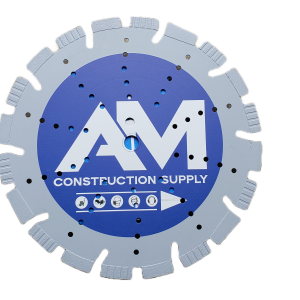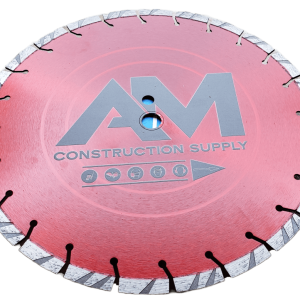Curious about diamond blades? Wondering if they are made of real diamonds? This blog post dives into the intriguing world of diamond blades, shedding light on whether they are indeed crafted from genuine diamonds. Delve into the facts behind these cutting tools and uncover the truth about their composition.
Whether you’re a DIY enthusiast, a professional contractor, or simply someone with an interest in construction materials, this exploration will provide clarity on an often-misunderstood subject. Buckle up for a fascinating journey through the realm of diamond blades as we embark on rigorous evidence analysis with a clear thesis.
Key Takeaways
- Diamond blades are not made entirely of real diamonds, but they contain synthetic diamonds or diamond segments for cutting hard materials.
- When comparing diamond blades to steel blades, the former offers superior cutting performance and durability, making them ideal for tough materials like concrete, stone, and asphalt.
- Understanding the wet and dry cutting techniques for diamond blades is crucial as it affects the blade’s performance, cooling, and dust control during cutting operations.
- Selecting the right diamond blade involves considering factors such as material to be cut, blade size, bond hardness, and the type of equipment used for cutting.
- Safety measures, including proper training, wearing protective gear, and ensuring a stable workpiece, are essential when using diamond blades to prevent accidents and injuries.
- Regular maintenance and care, such as cleaning the blade after use and storing it properly, can prolong the lifespan and efficiency of diamond blades.
Unveiling Diamond Blades
Composition
Diamond blades are not typically made with natural diamonds, but rather with synthetic diamonds. The composition of these blades consists of a metal core and diamond segments. These synthetic diamonds embedded in the blade’s segments provide the cutting edge, allowing for efficient cutting through various materials.
The synthetic diamonds used in diamond blades are carefully engineered to exhibit exceptional hardness and durability. This makes them ideal for applications that require precision cutting through hard materials such as concrete, asphalt, granite, marble, and other masonry products. The high thermal conductivity properties of these synthetic diamonds help dissipate heat during operation, preventing overheating and ensuring prolonged usage.
Properties
One remarkable property of diamond blades is their exceptional hardness. This characteristic enables them to withstand the rigors of cutting tough materials without losing their sharpness or structural integrity. Furthermore, these blades possess high thermal conductivity properties which aid in dispersing heat generated during the cutting process. This prevents overheating and ensures consistent performance over extended periods.
The combination of superior hardness and high thermal conductivity makes diamond blades suitable for a wide range of applications where precision cuts on hard surfaces are required. Whether it’s construction projects involving concrete or roadwork requiring asphalt cutting, these properties make diamond blades an indispensable tool for professionals across various industries.
Cutting Techniques
Diamond blades can be utilized using two primary techniques: wet cutting and dry cutting methods.
- Wet Cutting: In this method, water is used to cool down the blade during operation while also minimizing dust production from the material being cut.
- Dry Cutting: For certain applications where water cannot be employed or is impractical (such as indoor projects), dry cutting proves to be a suitable alternative.
Both wet and dry techniques offer distinct advantages based on specific project requirements; however, they both leverage the exceptional properties inherent in diamond blades to ensure precise cuts without compromising on efficiency or safety.
Real Diamonds or Not?
Common Misconceptions
One common misconception is that diamond blades are entirely made of real diamonds. However, this is not the case. In reality, diamond blades consist of a steel core and synthetic diamonds, not natural ones. Another widespread misconception is that these blades are only used for cutting diamonds. In fact, they are primarily used for cutting hard materials such as concrete, asphalt, stone, and ceramics.
It’s also a misconception that all diamond blades can be used interchangeably. Different types of diamond blades are designed for specific applications based on the material being cut and the type of equipment being used. For instance, a blade designed for cutting concrete may not perform well when cutting asphalt due to variations in hardness and abrasiveness between the materials.
Diamond Blade Bonds
The bond in a diamond blade plays a crucial role in its performance as it holds the synthetic diamonds in place on the blade’s edge during operation. This bond is typically made from various metallic powders combined with other elements to form different types of bonds such as metal, resin, or electroplated bonds.
Different types of bonds provide varying levels of blade hardness which directly impacts their ability to cut through different materials effectively without wearing out too quickly or becoming excessively dull after use.
Understanding the bond type is crucial for selecting the right blade for specific applications because each bond has its strengths and weaknesses depending on factors like material composition and intended use.
Diamond vs Steel Blades
Key Differences
Diamond blades are not made of real diamonds, but they use synthetic diamonds for cutting hard materials. On the other hand, steel or abrasive blades are composed of different materials like aluminum oxide or silicon carbide. These differences in composition and cutting capabilities make diamond blades stand out from their steel counterparts.
Understanding these distinctions is crucial when selecting the appropriate blade for a specific task. For instance, when cutting through hard substances like concrete, masonry, or stone tiles, using a diamond blade ensures precision and efficiency due to its synthetic diamond composition. Conversely, abrasive blades might be more suitable for softer materials such as wood or plastic.
Cutting Efficiency
One significant advantage of diamond blades over steel ones is their high cutting efficiency. When used with proper techniques and machinery settings, these specialized blades can minimize material wastage during cutting operations. This means that less material is lost during the cutting process compared to traditional steel or abrasive blades.
The high efficiency of diamond blades contributes to faster completion of tasks because they require fewer passes to achieve the desired cut than conventional alternatives do. This makes them highly desirable for professional contractors who need to complete projects quickly and accurately without compromising on quality.
Diamond Blades in Action
Angle Grinders
Diamond blades, although not made entirely of real diamonds, are commonly used with angle grinders for cutting through tough materials. These blades can effortlessly slice through concrete, stone, and metal. When using angle grinders equipped with diamond blades, it’s crucial to follow proper handling procedures and safety precautions to prevent accidents.
For example, when cutting concrete with a diamond blade on an angle grinder, users should wear protective gear such as goggles and gloves. It’s also important to ensure that the blade is suitable for the specific material being cut to avoid damage or injury. Proper training in operating an angle grinder is essential for safe usage.
Circular Saws
Circular saws fitted with diamond blades are highly effective tools for making precise and clean cuts in hard materials like concrete and ceramic tiles. These saws find wide application in construction sites and woodworking industries due to their ability to produce accurate cuts without chipping or cracking the material being worked on.
In practice, when using circular saws with diamond blades, it’s imperative to adhere strictly to safety guidelines provided by the manufacturer. This includes wearing appropriate personal protective equipment (PPE) such as ear protection, eye protection, and respiratory masks if necessary. Ensuring that the workpiece is securely clamped down before making any cuts is crucial for both accuracy and safety.
Wet and Dry Cutting Techniques
Advantages
Diamond blades are indeed real diamonds, but they are not the same as the ones found in jewelry. These blades offer several advantages over traditional abrasive blades. They provide precise cuts with minimal chipping or damage to the material being cut, making them ideal for projects that require a high level of accuracy. For instance, when cutting ceramic tiles during a home renovation project, diamond blades ensure clean edges without any cracks or breaks.
Moreover, the advantages of using diamond blades include their extended lifespan and cost-effectiveness. This means that even though diamond blades may have a higher initial cost than traditional abrasive blades, their longevity and superior performance make them more economical in the long run. Contractors who frequently use these tools benefit from reduced replacement costs and increased productivity due to less downtime for blade changes.
Selection Criteria
Several crucial factors need to be considered. Material type is one of the most important aspects to take into account when choosing a diamond blade because different materials require different types of cutting techniques. For example, cutting through concrete requires a different type of blade compared to slicing through asphalt.
blade size plays an essential role in ensuring efficient and effective cutting operations. Using an incorrect size could result in uneven cuts or potential safety hazards during operation.
Understanding the specific requirements of each job is crucial for selecting an appropriate diamond blade as well. By knowing whether you need wet or dry cutting techniques based on your project’s needs can significantly impact your choice of blade.
Proper selection criteria ensure optimal performance and safety during cutting operations by reducing risks such as kickbacks or overheating while also maximizing efficiency.
Choosing the Right Diamond Blade
Job Requirements
Different jobs require specific types of diamond blades based on material hardness and thickness. Understanding the job requirements is crucial for choosing the right blade diameter and segment height. For instance, cutting through hard materials like concrete or asphalt demands a diamond blade with a higher diamond concentration to withstand the abrasiveness. On the other hand, softer materials such as green concrete or asphalt call for a blade with a lower diamond concentration.
Job requirements also dictate whether wet or dry cutting techniques should be employed. Wet cutting is suitable for reducing dust and cooling down the blade during heavy-duty applications, while dry cutting offers convenience in certain situations where water isn’t accessible.
Blade Size
The size of a diamond blade significantly influences its compatibility with different tools and job requirements. When selecting a diamond blade size, it’s essential to consider the depth of cut required for a particular application. Larger blades are ideal for heavy-duty tasks where deeper cuts are necessary, such as road construction projects or demolition work. Conversely, smaller blades offer precision cuts and are more suited for applications like tile cutting or small-scale masonry work.
Larger diameter blades often feature higher horsepower ratings due to their use in heavy-duty equipment like walk-behind saws or large handheld saws. Smaller diameter blades are compatible with lighter machinery commonly used in residential settings.
Lifespan Considerations
The lifespan of diamond blades varies based on usage frequency, material type being cut, and maintenance practices followed by users. Blades used incorrectly can wear out prematurely due to overheating from friction caused by using them on materials they weren’t designed for.
Proper maintenance plays an integral role in extending the lifespan of diamond blades; cleaning off debris after each use prevents corrosion which can weaken segments over time. Regular inspection ensures safe usage and prolongs the lifespan; any signs of damage should prompt immediate replacement to prevent accidents during operation.
Safety in Using Diamond Blades
Safety Measures
When using diamond blades, it’s crucial to prioritize safety. This involves wearing the right personal protective equipment (PPE), such as goggles, gloves, and hearing protection. By maintaining a safe distance from the cutting area while operating machinery with diamond blades, workers can reduce the risk of accidents and injuries. Following the manufacturer’s guidelines for safe usage is essential for minimizing potential risks associated with using diamond blades.
For example, when cutting concrete or masonry with a diamond blade, workers should wear goggles to protect their eyes from any flying debris. Gloves are also necessary to safeguard their hands from sharp edges or abrasive materials during handling. Furthermore, hearing protection is vital when working with high-powered tools that use diamond blades to minimize the risk of noise-induced hearing loss.
It’s important for operators to stay at a safe distance from the cutting area while using machinery equipped with diamond blades. This precautionary measure helps prevent accidental contact with rotating parts or materials being cut. Following manufacturer instructions ensures that users operate equipment within its designed parameters and limitations.
Risks and Hazards
Using diamond blades carries certain risks and hazards that need to be addressed diligently by operators. These include kickback – a sudden reaction caused by pinching of the saw blade along with overheating due to prolonged usage without proper cooling measures in place.
Improper handling or using damaged or worn-out diamond blades can lead to hazardous situations during operation. It’s imperative for workers to inspect diamond blades regularly for signs of wear and tear before each use. Any cracks, missing segments, or uneven wear patterns indicate potential hazards that require immediate attention.
Awareness of these potential risks is key in implementing preventive measures effectively when working with diamond blades on various materials like concrete, asphalt, tile, brickwork among others.
Benefits of Diamond Blades
Durability
Diamond blades are not made with natural diamonds, but rather with synthetic diamond particles. This composition results in exceptional durability, allowing for prolonged usage without significant loss of cutting performance. Proper care and maintenance contribute to maintaining the durability of diamond blades, ensuring that they remain effective over time.
For example, when used in construction, a diamond blade can withstand the rigors of cutting through tough materials such as concrete and asphalt. The synthetic diamond composition ensures that the blade maintains its sharpness and cutting ability even after extended use.
Precision Cutting
One of the key benefits of using diamond blades is their ability to enable precision cutting without causing excessive material damage. In applications where accuracy is paramount, such as in the fabrication of intricate stone countertops or delicate ceramic tiles, precision cuts are essential. Diamond blades make it possible to achieve clean and precise cuts without compromising the integrity or quality of the material being cut.
In industries like masonry and woodworking, precision cutting is crucial for creating seamless joints and achieving a high-quality finish. The sharpness and hardness of synthetic diamonds allow for smooth and accurate cuts on various materials, enhancing overall efficiency and reducing wastage.
Maintenance and Care of Diamond Blades
Extending Lifespan
Proper storage conditions are essential to prevent damage to diamond blades when not in use. Keeping them in a dry environment helps avoid corrosion or rust on the metal core, extending their lifespan. Regular cleaning is also crucial as it removes debris buildup that can affect blade performance over time. Following the manufacturer’s recommendations for usage and maintenance further ensures that diamond blades remain effective for an extended period.
Diamond blades are designed for specific purposes, and using them beyond their intended applications can significantly reduce their lifespan. For instance, using a blade meant for cutting concrete to cut asphalt could lead to premature wear and tear. Therefore, adhering to the manufacturer’s guidelines regarding usage prevents unnecessary strain on the blade, preserving its longevity.
Proper Storage
Storing diamond blades in a dry environment is vital as moisture can cause corrosion or rust on the metal core, leading to deterioration over time. Avoiding exposure to extreme temperatures such as excessive heat or cold helps maintain the integrity of the blade’s components by preventing warping or cracking due to thermal expansion and contraction.
Improper storage conditions can compromise the structural integrity of diamond blades, rendering them ineffective when needed most. For example, leaving them exposed outdoors where they are susceptible to moisture and temperature changes could result in irreversible damage. Therefore, ensuring proper storage guarantees that diamond blades remain ready for optimal performance whenever they are required.
Closing Thoughts
The use of diamond blades is a game-changer in the construction and manufacturing industries. Their unparalleled cutting efficiency, durability, and versatility make them indispensable for various cutting applications. Whether it’s wet or dry cutting, selecting the right diamond blade is crucial for achieving optimal results and ensuring safety. Proper maintenance and care are essential to prolonging the lifespan of these valuable tools. Understanding the differences between diamond and steel blades is also vital in making informed decisions for specific cutting needs.
For those venturing into construction or industrial work, it’s imperative to delve deeper into the world of diamond blades to harness their full potential. By staying informed about the selection, usage, and maintenance of these blades, individuals can enhance their efficiency and safety while working with these powerful tools.
Frequently Asked Questions
Are diamond blades made of real diamonds?
Diamond blades are not typically made entirely of natural diamonds. Instead, they consist of a metal core and synthetic diamond crystals that are bonded to the core using various methods. These synthetic diamonds provide the cutting edge and durability required for cutting hard materials.
How do diamond blades differ from steel blades?
Diamond blades use synthetic diamonds or diamond-coated particles on their edges to cut through hard materials like concrete, asphalt, and stone. On the other hand, steel blades are designed for cutting softer materials such as wood and plastic. Diamond blades offer superior performance.
What are the benefits of using diamond blades?
Using diamond blades offers several advantages including faster cutting speeds, longer lifespan due to their hardness, ability to cut through hard materials with precision, reduced dust production during cutting compared to other blade types, and versatility in wet or dry cutting applications.
What safety measures should be taken when using diamond blades?
When using diamond blades, it’s crucial to wear appropriate personal protective equipment (PPE) such as safety goggles, gloves, hearing protection, and a dust mask. Ensuring that the blade is properly mounted on the tool and following recommended operating procedures can help prevent accidents.
How should one choose the right diamond blade for a specific application?
Selecting the right diamond blade involves considering factors such as material type being cut (concrete vs asphalt), hardness of material (reinforced concrete vs natural stone), wet or dry cutting requirements, machine compatibility (angle grinder vs circular saw), and desired finish quality. Consulting with professionals can also provide valuable guidance.





